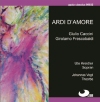ARDI D'AMORE
 Werke von Giulio Caccini , Girolamo Frescobaldi
Werke von Giulio Caccini , Girolamo Frescobaldimit Ute Kreidler (Sopran)
Johannes Vogt (Theorbe)
Track-List:
1. Amor l´ali m´ìmpenna (Caccini)

2. Cosi, mi disprezzate (Frescobaldi)

3. Ti lascio, anima mia (Frescobaldi)

4. Sferina (Kapsberger)

5. Vanne, o carta amorosa (Frsecobaldi)

6. Al fonte al prato (Caccini)

7. Vor partite, mio sole (Frescobaldi)

8. Toccata (Piccini)

9. La bella man vi stringo (Caccini)

10. A miei pianti al fine un di (Frescobaldi)

11. Ardi, cor mio (Caccini)

12. Pssacaglia (Kapsberger)

13. O che felice giorno (Caccini)

14. Di licori un gurado altero (Frescobaldi)

15. A quei sospir ardenti (Caccini)

16. Toccata (Frescobaldi)

17. Se l´aura spira (Frescobaldi)

18. Non mi negate, ohime (Frescobaldi)

19. Tu sai pur, dolce mio (Frescobaldi)

20. Fillide mia (Caccini)

Ardi D'Amore
About the works:
The vocal music of Caccini and Frescobaldi has fascinated us ever since we started making music together. With the development of the monodic style, Giulio Caccini (1551 - 1618) and other Florentine musicians helped to establish the close linking of emotion, text and musical expression necessary for the art of song composition. It was at this time, too, that opera was invented in Florence – a musical genre which also creates its effects through the emotional link between music and text.
Based in particular on his works for organ and harpsichord and his solo public performances, the fame of Girolamo Frescobaldi (1583 - 1643) spread throughout Europe. During the time he lived and worked in Florence he published two volumes of songs which can be seen as an act of homage to Caccini, who had been his predecessor at the court of the Medici. Together with Claudio Monteverdi, Caccini and Frescobaldi were among the most important forerunners of Baroque music.
We wanted to compare and contrast the music of Caccini and Frescobaldi, with their surprising harmonies and wide range of mood, by placing their works side by side. We aimed to record them in such a way that it would be possible to make the hearer appreciate the grace of the melodies and the bold-seeming ornamentation in all their emotional transparency.
We have therefore abandoned the stereo localisation microphone technique which is usually adopted for classical music, and made a conscious decision instead to position ourselves near the studio microphones. This gave us the opportunity of introducing a very special intimacy into both the musical and vocal expression. We were inspired to do this through our concerts and recordings with jazz musicians. We hope that this closeness and the virtual room acoustics will reach the listener, regardless of where he is sitting, in contrast to the traditional classical recording technique which mostly attempts to reproduce a localised acoustic, in which the listener is intended to get the impression that he is actually present in the room in question.
Caccini opened his volume of songs "Le Nuove Musiche" with a treatise on musical theory. Like many other achievements in art and science of the modern age, the invention of monody was explained by means of a reference to classical Greek culture. The music was intended to serve the text, the content; the supreme goal of music was to convey the sensuous and emotional message of the poem. In order to make the text more easily comprehensible, the work was composed for a solo voice accompanied by a basso continuo, which was mostly performed on the theorbo.
The ornamentation in Caccini’s songs may seem rather artificial to us today. They owe their particular aesthetic charm to Caccini’s determination to counter the method of performance common among singers of the time, who shared a virtuoso mania for self-promotion by introducing over-exaggerated ornamentation wherever they felt like it. He composed each ornament down to the very last note in accordance with his own musical ideas, so that they could serve entirely the content and emotionality of the text. It is our personal ambition to reproduce this by giving the ornamentation a light, natural quality like breathing in and out. The ornamentation is intended to serve as an expression of the emotional content.
G. Caccini and G. Frescobaldi never met, and yet Frescobaldi published only two volumes of songs, both during his time in Florence. They are consciously composed in a historic style, as if they had been directly inspired by Caccini as an act of homage to the singer, composer and musical theorist who achieved fame at the court of the Medici.
We hope that our collection of songs and instrumental works will permit a comparison as well as providing an understanding of the musical links between them. May they also convey at the same time an idea of the relationship between courtship, jealousy and heartbreak during the late 16th and early 17th century. Both true emotion and heartfelt feeling are expressed in this dramatic interplay.
Ute Kreidler and Johannes Vogt
(Übersetzung ins Englische: Jane Michael)
Ute Kreidler, Soprano
Member of the ensemble "I Ciarlatani" (Music of the Middle Ages and Renaissance on historical instruments)
Member of the group "Between The Times" (Improvisations and new arrangements of old European melodies and musical works)
Since 1990: Chamber music with Johannes Vogt
Solo concert activities at home and abroad
Teacher of functional singing technique according to the method of Eugen Rabine
Johannes Vogt, Theorbo, Baroque guitar
Studied classical guitar and music in Heidelberg and Aachen
Specialises today in old music on original instruments
Concerts and CD production as a soloist, with the lute duo "Duo Panormo", the ensemble "I Ciarlatani", the Baroque orchestra "L’Arpa Festante" et al.
1997: Founded the group "Between The Times" with Knut Rössler (saxophone)
Joint CDs
"Im Silo - Alte Musik und Neue Improvisation" (Between The Times, upala 99024)
"Between The Times - Live" (Jazz Festival, Worms)
"Between The Times - Early Songs"
"Georg Forster, Teutsche Liedlein" (I Ciarlatani)
"Seelewig - ein geistliches Waldgedicht oder Freudenspiel", First recording of the first German opera by Sigismund Theophil Staden (I Ciarlatani)
Back to the list